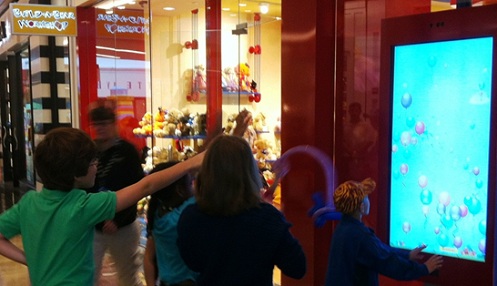Build-A-Bear Selects Kinect for Windows for "Store of the Future"
Build-A-Bear Workshop stores have been delivering custom-tailored experiences to children for 15 years in the form of make-your-own stuffed animals, but the company recently recognized that its target audience was gravitating toward digital devices. So it has begun advancing its in-store experiences to match the preferences of its core customers by incorporating digital screens throughout the stores—from the entrance to the stations where the magic of creating new fluffy friends happens.
A key part of Build-A-Bear's digital shift is their interactive storefront that's powered by Kinect for Windows. It enables shoppers to play digital games on either a screen adjacent to the store entrance or directly through the storefront window simply by using their bodies and natural gestures to control the game.

Children pop virtual balloons in a Kinect for Windows-enabled game at this Build-A-Bear store's front window.
"We're half retail, half theme park," said Build-A-Bear Director of Digital Ventures Brandon Elliott. The Kinect for Windows platform instantly appealed to Build-A-Bear as "a great enabler for personalized interactivity."
The Kinect for Windows application, launched at six pilot stores, uses skeletal tracking to enable two players (four hands) to pop virtual balloons (up to five balloons simultaneously) by waving their hands or by touching the screen directly. While an increasing number of retail stores use digital signage these days, Elliott noted: "What they're not doing is building a platform for interactive use."
"We wanted something that we could build on, that's a platform for ever-improving experiences," Elliott said. "With Kinect for Windows, there’s no learning curve. People can interact naturally with technology by simply speaking and gesturing the way they do when communicating with other people. The Kinect for Windows sensor sees and hears them."
"Right now, we're just using the skeletal tracking, but we could use voice recognition components or transform the kids into on-screen avatars," he added. "The possibilities are endless."
Part of the Build-A-Bear's vision is to create Kinect for Windows apps that tie into the seasonal marketing themes that permeate the stores. Elliott said that Build-A-Bear selected the combination of the Microsoft .NET Framework, Kinect for Windows SDK, and Kinect for Windows sensor specifically so that they can take advantage of existing developer platforms to build these new apps quickly.
“We appreciate that the Kinect for Windows SDK is developing so rapidly. We appreciate the investment Microsoft is making to continue to open up features within the Kinect for Windows sensor to us,” Elliott said. "The combination of Kinect for Windows hardware and software unlocks a world of new UI possibilities for us."
Microsoft developer and technical architect Todd Van Nurden and others at the Minneapolis-based Microsoft Technology Center helped Build-A-Bear with an early consultation that led to prototyping apps for the project.
"The main focus of my consult was to look for areas beyond simple screen-tied interactions to create experiences where Kinect for Windows activates the environment. Screen-based interactions are, of course, the easiest but less magical then environmental," Van Nurden said. "We were going for magical."
The first six Build-A-Bear interactive stores launched in October and November 2012 in St. Louis, Missouri; Pleasanton, California; Annapolis, Maryland; Troy, Michigan; Fairfax, Virginia, and Indianapolis, Indiana (details). Four of the stores have gesture-enhanced interactive signs at the entrance, while two had to be placed behind windows to comply with mall rules. Kinect for Windows can work through glass with the assistance of a capacitive sensor that enables the window to work as a touch screen, and an inductive driver that turns glass into a speaker.
So far, Build-A-Bear has been thrilled with what Elliott calls "fantastic" results. "Kids get it," he said. "We have a list of apps we want to build over the next couple of years. We can literally write an app for one computer in the store, and put it anywhere."
Kinect for Windows team
Key Links